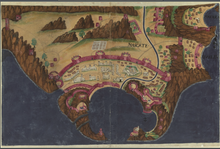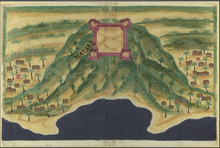66:
397:
47:
58:
17:
409:
385:
361:
337:
74:
373:
163:. Arabian horses exported through Oman, mainly conveyed to Hormuz, the regional sorting centre for horses, were considered among the best in the world. Muscat specialized in producing a specialized horse bedding to ensure the animals safe journey, called "herb of Muscat" or "Mecca straw". The horse trade was extremely profitable, each animal being sold from the equivalent of 1000 to 2000
349:
134:. The Kingdom of Hormuz was dissolved and the Portuguese relocated their forces to Oman, which was placed under the direct rule of a Portuguese captain-general, seated in Muscat. From Oman the Portuguese not only developed the trade in the region but conducted attacks on the Persian coast on English or Dutch navigation in the Gulf.
137:
Julfar was captured by the
Yarubids in 1633. Sohar followed in 1643. Muscat was besieged by the Yarubids in 1648, and peace treaty negotiated with the Portuguese, but the city was again attacked two years later and fell. In 1656 the Portuguese evacuated Khasab, thus putting an end to Portuguese rule
65:
158:
gum, dates, raisins, salt and dried fish. Cairo production, producted from coconut fibers and used in naval rigging was meaningful. Some small scale naval industry took place at Muscat. Nomadic bedouins moved flocks of goats and sheep from remote areas to the coastline cities. Camel caravans moved
104:
The sheikh of Muscat Râshid b. Ahmad Muscatî supported the
Portuguese, and in turn the Portuguese protected him from Omani rivalries, namely the wâzir of Qalhât, Ra’îs Shebabdîn, excessive taxation from Hormuz, and Banu Jabr raids from the interior. Muscat became increasingly important to the
105:
logistics of
Portuguese armadas operating in the Persian Gulf. In 1521, Hormuz revolted against Portugal, and sheikh Rashid was ordered to massacre all Portuguese in Muscat, but he refused. He was appointed vizier of Hormuz in 1529, and succeeded upon his death in 1534 by his son Ahmad.
101:. Hormuz and its provinces were thus reduced to a Portuguese protectorate, and since then, Portuguese merchants and military garrisons were established on Oman, most importantly Muscat, due to its sheltered deep-water harbour.
530:
Dejanirah Couto, "Muscat and the
Portuguese: economic and political dynamics in the early 16th century (1507-1529)", Arabian Humanities , 15 | 2022, mis en ligne le 01 janvier 2022, consulté le 20 juillet 2023. URL :
92:
conquered the coastal cities of Oman with a six ship squadron and about 500 men, imposing the payment of a tribute in exchange for autonomous rule. In 1515, as
Governor of India Albuquerque captured the city of
167:, and profits estimated at 300 and 500%. They were only embarked in Muscat, Qalhat and Khorfakkan. From the coastal cities, rice, sugar and spices were imported mainly from India into the hinterland.
175:
Along the Omani coast the
Portuguese erected forts and installed garrisons to defend the territory from incursions from pirates, the Persians and local Arab tribes from the interior.
396:
186:– headquarters of the Portuguese captain-general of the sea of Hormuz responsible for all Portuguese operations in Oman, the Persian Gulf and Red Sea.
464:
450:
111:
Muscat was raided by
Ottoman fleets in 1546, 1551, and again in 1581. The Portuguese fortified the city in their aftermath, concluding the forts
565:
in GENIUS LOCI – LUGARES E SIGNIFICADOS | PLACES AND MEANINGS – VOLUME 2 by Centro de História de Além-Mar, Nova
University of Lisbon, p.223
108:
In 1523, Sohar rebelled, but it was pacified by Dom Luís de
Menezes, while Muscat and Qalhat rebelled in 1526 but were likewise pacified.
628:
680:
27:
refers to the period during which the northern coastal cities of Oman were under
Portuguese rule, between 1507 and 1656.
675:
98:
481:
Volume I. Raymundo António de Bulhão Pato, Lisboa, Typ. da Academia Real das Sciencias de Lisboa 1884, pp. 9–10
496:
Volume I. Raymundo António de Bulhão Pato, Lisboa, Typ. da Academia Real das Sciencias de Lisboa 1884, p. 10
491:
476:
425:
131:
574:
547:
670:
618:
89:
31:
51:
46:
8:
408:
430:
624:
645:
360:
160:
336:
220:
127:
57:
34:
in 1507, and remained under Portuguese control until they were expelled by the
16:
384:
664:
81:
In the early 16th century, the northern coast of Oman was a province of the
563:
DAS FORTIFICAÇÕES PORTUGUESAS EM MASCATE: ANÁLISE MORFOLÓGICA E TERRITORIAL
35:
30:
The coastal region was conquered by Portuguese forces under the command of
532:
372:
295:
193:
120:
348:
620:
The Blood-red Arab Flag: An Investigation Into Qasimi Piracy, 1797–1820
493:
Cartas de Afonso de Albuquerque, Seguidas de Documentos que as Elucidam
478:
Cartas de Afonso de Albuquerque, Seguidas de Documentos que as Elucidam
256:
50:
16th century Portuguese depiction of a bathing scene at Muscat, in the
146:
Basic exports of Oman in the 16th century included cereals such as
97:
itself, by the entrance of the Persian Gulf, and erected on it the
536:
280:
73:
247:
211:
202:
183:
147:
644:
Beck, Sanderson (2004). "East Africa, Portuguese, and Arabs".
322:
313:
271:
238:
229:
164:
151:
94:
82:
88:
In 1507, the Portuguese captain-major of the seas of Arabia
561:
Ana Catarina Gonçalves Lopes, Jorge Manuel Simões Correia:
304:
155:
159:
from Oman across the Arabian peninsula and towards the
582:
20:Portuguese depiction of Muscat by António Bocarro
662:
594:
170:
77:Fort of Matara as depicted by António Bocarro
576:Fort of Nossa Senhora da Conceição de Hormuz
549:Fort of Nossa Senhora da Conceição de Hormuz
154:, fresh fruit and oils, coffee, incense and
526:
524:
522:
119:(Jalali) in 1588. A fort was erected at
72:
64:
56:
45:
15:
533:http://journals.openedition.org/cy/6966
520:
518:
516:
514:
512:
510:
508:
506:
504:
502:
663:
616:
588:
41:
643:
600:
499:
13:
610:
99:Fort of Our Lady of the Conception
14:
692:
617:Davies, Charles E. (1997-01-01).
647:Middle East & Africa to 1875
407:
395:
383:
371:
359:
347:
335:
126:In 1622, Hormuz was captured by
537:https://doi.org/10.4000/cy.6966
623:. University of Exeter Press.
568:
555:
541:
484:
469:
458:
443:
1:
436:
171:Portuguese fortresses in Oman
7:
419:
10:
697:
676:Former Portuguese colonies
490:Afonso de Albuquerque, in
475:Afonso de Albuquerque, in
426:Battle of the Gulf of Oman
328:
132:English East India Company
85:, ruled by its governors.
141:
69:Al Mirani Fort at Muscat
61:Al Jalali Fort at Muscat
681:Oman–Portugal relations
452:Década Segunda da Ásia
78:
70:
62:
54:
21:
90:Afonso de Albuquerque
76:
68:
60:
49:
32:Afonso de Albuquerque
19:
130:with the aid of the
578:, in Fortalezas.org
551:, in Fortalezas.org
535: ; DOI :
449:Barros, João de,
431:Portuguese Socotra
79:
71:
63:
55:
52:Códice Casanatense
42:History, 1507–1656
22:
630:978-0-85989-509-5
83:Kingdom of Hormuz
688:
657:
655:
654:
640:
638:
637:
604:
598:
592:
586:
580:
572:
566:
559:
553:
545:
539:
528:
497:
488:
482:
473:
467:
462:
456:
447:
411:
399:
387:
375:
363:
351:
339:
115:(Al-Mirani) and
696:
695:
691:
690:
689:
687:
686:
685:
671:History of Oman
661:
660:
652:
650:
635:
633:
631:
613:
611:Further reading
608:
607:
599:
595:
587:
583:
573:
569:
560:
556:
546:
542:
529:
500:
489:
485:
474:
470:
463:
459:
448:
444:
439:
422:
415:
412:
403:
400:
391:
388:
379:
376:
367:
364:
355:
352:
343:
340:
331:
173:
161:Iranian plateau
144:
138:in the region.
44:
25:Portuguese Oman
12:
11:
5:
694:
684:
683:
678:
673:
659:
658:
641:
629:
612:
609:
606:
605:
593:
581:
567:
554:
540:
498:
483:
468:
465:Barros, pg 101
457:
441:
440:
438:
435:
434:
433:
428:
421:
418:
417:
416:
413:
406:
404:
401:
394:
392:
389:
382:
380:
377:
370:
368:
365:
358:
356:
353:
346:
344:
341:
334:
330:
327:
326:
325:
316:
307:
298:
289:
283:
274:
265:
259:
250:
241:
232:
223:
214:
205:
196:
187:
172:
169:
143:
140:
128:Safavid Persia
43:
40:
9:
6:
4:
3:
2:
693:
682:
679:
677:
674:
672:
669:
668:
666:
649:
648:
642:
632:
626:
622:
621:
615:
614:
602:
597:
591:, p. 59.
590:
585:
579:
577:
571:
564:
558:
552:
550:
544:
538:
534:
527:
525:
523:
521:
519:
517:
515:
513:
511:
509:
507:
505:
503:
495:
494:
487:
480:
479:
472:
466:
461:
454:
453:
446:
442:
432:
429:
427:
424:
423:
410:
405:
398:
393:
386:
381:
374:
369:
362:
357:
350:
345:
338:
333:
332:
324:
320:
317:
315:
311:
308:
306:
302:
299:
297:
293:
290:
287:
284:
282:
278:
275:
273:
269:
266:
263:
260:
258:
254:
251:
249:
245:
242:
240:
236:
233:
231:
227:
224:
222:
218:
215:
213:
209:
206:
204:
200:
197:
195:
191:
188:
185:
181:
178:
177:
176:
168:
166:
162:
157:
153:
149:
139:
135:
133:
129:
124:
122:
118:
114:
109:
106:
102:
100:
96:
91:
86:
84:
75:
67:
59:
53:
48:
39:
37:
33:
28:
26:
18:
651:. Retrieved
646:
634:. Retrieved
619:
596:
584:
575:
570:
562:
557:
548:
543:
492:
486:
477:
471:
460:
451:
445:
318:
309:
300:
291:
285:
276:
267:
261:
252:
243:
234:
225:
216:
207:
198:
189:
179:
174:
145:
136:
125:
116:
112:
110:
107:
103:
87:
80:
29:
24:
23:
589:Davies 1997
296:Khor Fakkan
121:Khor Fakkan
665:Categories
653:2013-11-11
636:2013-11-11
437:References
257:Al Badiyah
601:Beck 2004
288:– Mocombi
286:Mocombira
123:in 1621.
113:Almirante
36:Ya'rubids
420:See also
366:Corfação
292:Corfação
221:Qurayyat
199:Calaiate
117:São João
378:Curiate
342:Libedia
329:Gallery
281:Muttrah
264:– Limah
253:Libedia
217:Curiate
208:Cassapo
180:Mascate
627:
354:Quelba
323:Kalba
319:Quelba
277:Matara
248:Julfar
244:Julfar
212:Khasab
203:Qalhat
184:Muscat
165:ducats
148:barley
95:Hormuz
455:p. 95
402:Dibba
314:Sohar
272:Madha
239:Dubbo
230:Dibba
194:Barka
190:Borca
152:wheat
142:Trade
625:ISBN
414:Soar
390:Sibo
310:Soar
305:Seeb
301:Sibo
268:Madá
262:Lima
235:Dubo
226:Doba
156:aloe
150:and
38:.
667::
501:^
321:–
312:–
303:–
294:–
279:–
270:–
255:–
246:–
237:–
228:–
219:–
210:–
201:–
192:–
182:–
656:.
639:.
603:.
Text is available under the Creative Commons Attribution-ShareAlike License. Additional terms may apply.




